
USS Montana (ACR-13/CA-13), also referred to as "Armored Cruiser No. 13", later renamed Missoula and reclassified CA-13, was a Tennessee-class armored cruiser of the United States Navy. She was built by the Newport News Drydock & Shipbuilding Co.; her keel was laid down in April 1905, she was launched in December 1906, and she was commissioned in July 1908. The final class of armored cruisers to be built for the US Navy, Montana and her sisters were armed with a main battery of four 10-inch (254 mm) guns, and were capable of a top speed of 22 knots.

USS Mercy (ID-1305/AH-4) was a hospital ship in the United States Navy during World War I. She was the first U.S. Navy ship of that name. The ship was previously known as SS Saratoga, a steamer for the Ward Line on the New York to Havana route, and considered the fastest steamship in coastal trade. Before being purchased by the Navy, the ship was briefly employed as United States Army transport ship USAT Saratoga, a career that ended after a collision off Staten Island, New York.

USS Comfort (AH-3) was a hospital ship for the United States Navy in World War I. She was the sister ship of USS Mercy (AH-4) but the two ships were not of a ship class. Comfort was known as SS Havana in passenger service for the Ward Line, and as USAT Havana in United States Army service before her Navy service. Her name was restored to Havana in 1927, and she was renamed SS Yucatán in 1935, and SS Agwileon in 1941. In World War II, she was known as USAT Agwileon and USAHS Shamrock in service for the United States Army.
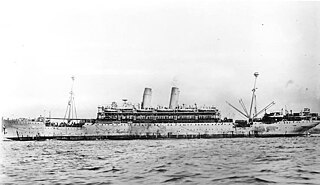
USS Princess Matoika (ID-2290) was a transport ship for the United States Navy during World War I. Before the war, she was a Barbarossa-class ocean liner that sailed as SS Kiautschou for the Hamburg America Line and as SS Princess Alice for North German Lloyd. After her World War I Navy service ended, she served as the United States Army transport ship USAT Princess Matoika. In post-war civilian service she was SS Princess Matoika until 1922, SS President Arthur until 1927, and SS City of Honolulu until she was scrapped in 1933.

USS Lenape (ID-2700) was a troop transport for the United States Navy in 1918, during World War I. She was launched in 1912 as SS Lenape, a passenger steamer for the Clyde Line. After the entry of the United States into World War I in 1917, she was chartered by the United States Army as transport USAT Lenape. After her Navy service ended in October 1918, she was returned to the Army.
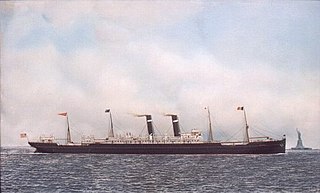
SS Finland was an American-flagged ocean liner built in 1902 for the Red Star Line. During World War I she served as a transport for the United States Navy named USS Finland (ID-4543). Before her Navy service in 1917, she was also USAT Finland for the United States Army.

SS Kroonland was an ocean liner for International Mercantile Marine (IMM) from her launch in 1902 until she was scrapped in 1927. Kroonland was the sister ship of Finland and a near sister ship of Vaderland and Zeeland of the same company. Kroonland sailed for IMM's Red Star Line for 15 years, and also sailed for IMM's American Line and Panama Pacific Line. During World War I, the ship served as United States Army transport USAT Kroonland through April 1918, and as the Navy auxiliary USS Kroonland (ID-1541) from April 1918 to October 1919.

USS Rijndam (ID-2505) was a transport for the United States Navy during World War I. Both before and after her Navy service she was known as SS Rijndam or Ryndam as an ocean liner for the Holland America Line.

USS Martha Washington (ID‑3019) was a transport for the United States Navy during World War I named for Martha Washington, the first First Lady of the United States. She was originally ocean liner SS Martha Washington for the Austro-American Line before the war. Before and after her Navy service she was the United States Army transport USAT Martha Washington. The liner was sold to the Italian Cosulich Line in 1922. In 1932, when Cosulich was absorbed into Italia Flotte Riunite, the ship was renamed SS Tel Aviv. The ship was scrapped in 1934.
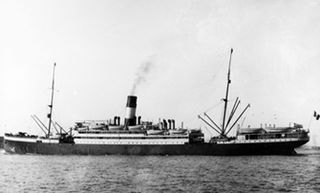
SS Taormina was a transatlantic ocean liner that was launched in Scotland in 1907 for an Italian shipping line. She was owned successively by Italia Società di Navigazione a Vapore, Lloyd Italiano and Navigazione Generale Italiana (NGI). Taormina was briefly chartered as a troop ship for the US Armed Forces in 1918. She was scrapped in 1929.
SS Caserta was an Italian ocean liner named for the city of Caserta in the Campania region of Italy. She was previously known as SS Maritzburg and SS Mendoza, and was later renamed SS Venezuela. Launched in 1904 as Maritzburg for the Bucknall Line, the ship was sold to Lloyd Italiano in 1905 and renamed Mendoza. Renamed Caserta in 1914, she was placed under the Navigazione Generale Italiana banner in 1918. During World War I she was employed as a troopship carrying United States troops to France as part of the United States Navy Cruiser and Transport Force. In 1923, she was renamed Venezuela and transferred to La Veloce for South American service, but reverted to NGI control in 1924. She was scrapped in 1928.
SS Re d'Italia was an Italian ocean liner for Lloyd Sabaudo named for the King of Italy. Launched in 1906, she sailed between Italy and New York and South America for most of her career. During World War I she was employed as a troopship carrying United States troops to France as part of the United States Navy Cruiser and Transport Force. She was scrapped in 1929.

USS Tenadores was a transport ship for the United States Navy during World War I. Before the war she was known as SS Tenadores in the service of the United Fruit Company. Before her Navy service, she served as a United States Army transport under the name USAT Tenadores.

Czar, or Царь in Russian, was an ocean liner for the Russian American Line before World War I. The ship was later named Estonia for the Baltic American Line, Pułaski for the PTTO and as a UK Ministry of War Transport troopship, and as Empire Penryn after World War II. The liner was built in Glasgow for the Russian American Line in 1912 and sailed on North Atlantic routes from Libau to New York. On one eastbound voyage in October 1913, Czar was one of ten ships that came to the aid of the burning Uranium Line steamer Volturno.
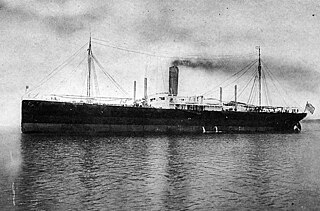
SS Dakotan was a cargo ship built in 1912 for the American-Hawaiian Steamship Company that served as a transport ship in the United States Army Transport Service in World War I, and then was transferred to the Soviet Union under Lend-Lease in World War II before being finally scrapped in 1969. During World War I, she was taken over by the United States Army as USAT Dakotan. Near the end of that war she was transferred to the United States Navy and commissioned as USS Dakotan (ID-3882). During World War II, the ship was transferred to the Soviet Union and renamed SS Zyrianin.
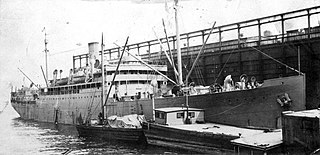
USS Henry R. Mallory (ID-1280) was a transport for the United States Navy during World War I. She was also sometimes referred to as USS H. R. Mallory or as USS Mallory. Before her Navy service she was USAT Henry R. Mallory as a United States Army transport ship. From her 1916 launch, and after her World War I military service, she was known as SS Henry R. Mallory for the Mallory Lines. Pressed into service as a troopship in World War II by the War Shipping Administration, she was torpedoed by the German submarine U-402 in the North Atlantic Ocean and sank with the loss of 272 men—over half of those on board.

SS El Occidente was a cargo ship for the Morgan Line, a subsidiary of the Southern Pacific Company. During World War I, she was known as USAT El Occidente in service with the United States Army and as USS El Occidente (ID-3307) in service with the United States Navy. At the end of war, she reverted to her original name of SS El Occidente.

SS El Sol was a cargo ship built in 1910 for the Morgan Line, a subsidiary of the Southern Pacific Company. During World War I, she was known as USAT El Sol in service with the United States Army and as USS El Sol (ID-4505) in service with the United States Navy. At the end of war, she reverted to her original name of SS El Sol.

SS El Oriente was a cargo ship built in 1910 for the Morgan Line, a subsidiary of the Southern Pacific Company. During World War I, she was known as USS El Oriente (ID-4504) in service with the United States Navy. At the end of war, she reverted to her original name of SS El Oriente. During World War II she was chartered by the International Committee of the Red Cross (ICRC) as SS Henri Dunant, but reverted to her original name of SS El Oriente at the end of the charter.

SS Montanan was a cargo ship built in 1912 for the American-Hawaiian Steamship Company. During World War I service for the United States Army Transport Service, she was known as USAT Montanan. Montanan was built by the Maryland Steel Company as one of eight sister ships for the American-Hawaiian Steamship Company, and was employed in inter-coastal service via the Isthmus of Tehuantepec and the Panama Canal after it opened.

















